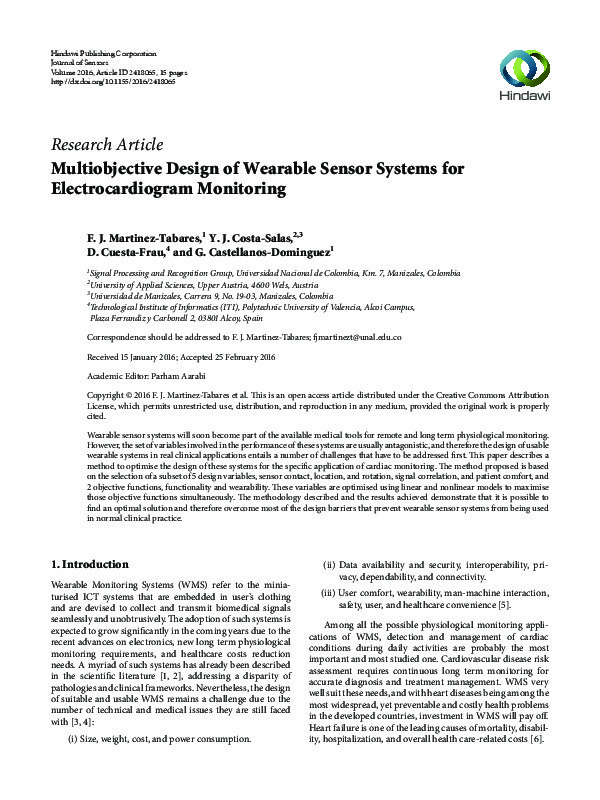JavaScript is disabled for your browser. Some features of this site may not work without it.
Buscar en RiuNet
Listar
Mi cuenta
Estadísticas
Ayuda RiuNet
Admin. UPV
Multiobjective design of wearable sensor systems for electrocardiogram monitoring
Mostrar el registro sencillo del ítem
Ficheros en el ítem
| dc.contributor.author | Martinez-Tabares, F. J.
|
es_ES |
| dc.contributor.author | Costa-Salas, Y. J.
|
es_ES |
| dc.contributor.author | Cuesta Frau, David
|
es_ES |
| dc.contributor.author | Castellanos-Dominguez, G.
|
es_ES |
| dc.date.accessioned | 2017-06-15T12:04:17Z | |
| dc.date.available | 2017-06-15T12:04:17Z | |
| dc.date.issued | 2016 | |
| dc.identifier.issn | 1687-725X | |
| dc.identifier.issn | 1687-7268 | |
| dc.identifier.uri | http://hdl.handle.net/10251/82890 | |
| dc.description.abstract | Wearable sensor systems will soon become part of the available medical tools for remote and long term physiological monitoring. However, the set of variables involved in the performance of these systems are usually antagonistic, and therefore the design of usable wearable systems in real clinical applications entails a number of challenges that have to be addressed first. This paper describes a method to optimise the design of these systems for the specific application of cardiac monitoring. The method proposed is based on the selection of a subset of 5 design variables, sensor contact, location, and rotation, signal correlation, and patient comfort, and 2 objective functions, functionality and wearability. These variables are optimised using linear and nonlinear models to maximise those objective functions simultaneously. The methodology described and the results achieved demonstrate that it is possible to find an optimal solution and therefore overcome most of the design barriers that prevent wearable sensor systems from being used in normal clinical practice. | es_ES |
| dc.description.sponsorship | This work was supported by the Departamento Administrativo de Ciencia, Tecnologia e Innovacion, COLCIENCIAS, Republic of Colombia, under Grant nos. 511 and 523. | en_EN |
| dc.language | Inglés | es_ES |
| dc.publisher | Hindawi Publishing Corporation | es_ES |
| dc.relation.ispartof | Journal of Sensors | es_ES |
| dc.rights | Reconocimiento - No comercial - Sin obra derivada (by-nc-nd) | es_ES |
| dc.subject | Evolutionary algorithms | es_ES |
| dc.subject | Challenges | es_ES |
| dc.subject | Networks | es_ES |
| dc.subject | Platform | es_ES |
| dc.subject | Machine | es_ES |
| dc.subject | Index | es_ES |
| dc.subject.classification | ARQUITECTURA Y TECNOLOGIA DE COMPUTADORES | es_ES |
| dc.title | Multiobjective design of wearable sensor systems for electrocardiogram monitoring | es_ES |
| dc.type | Artículo | es_ES |
| dc.identifier.doi | 10.1155/2016/2418065 | |
| dc.relation.projectID | info:eu-repo/grantAgreement/COLCIENCIAS//511/ | es_ES |
| dc.relation.projectID | info:eu-repo/grantAgreement/COLCIENCIAS//523/ | es_ES |
| dc.rights.accessRights | Abierto | es_ES |
| dc.contributor.affiliation | Universitat Politècnica de València. Instituto Universitario Mixto Tecnológico de Informática - Institut Universitari Mixt Tecnològic d'Informàtica | es_ES |
| dc.contributor.affiliation | Universitat Politècnica de València. Escuela Politécnica Superior de Alcoy - Escola Politècnica Superior d'Alcoi | es_ES |
| dc.description.bibliographicCitation | Martinez-Tabares, FJ.; Costa-Salas, YJ.; Cuesta Frau, D.; Castellanos-Dominguez, G. (2016). Multiobjective design of wearable sensor systems for electrocardiogram monitoring. Journal of Sensors. (2418065):1-15. https://doi.org/10.1155/2016/2418065 | es_ES |
| dc.description.accrualMethod | S | es_ES |
| dc.relation.publisherversion | http://dx.doi.org/10.1155/2016/2418065 | es_ES |
| dc.description.upvformatpinicio | 1 | es_ES |
| dc.description.upvformatpfin | 15 | es_ES |
| dc.type.version | info:eu-repo/semantics/publishedVersion | es_ES |
| dc.description.issue | 2418065 | es_ES |
| dc.relation.senia | 327822 | es_ES |
| dc.contributor.funder | Departamento Administrativo de Ciencia, Tecnología e Innovación, Colombia | es_ES |








